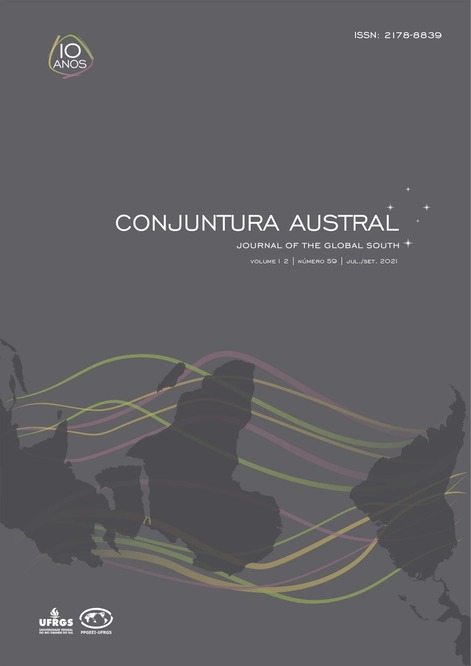The military woman in Brazil in the 21st century: an analysis based on the seven indicators proposed by Helena Carreiras (2006)
DOI:
https://doi.org/10.22456/2178-8839.113848Keywords:
Military Women, Armed Forces, Defense,Abstract
This article aims to achieve an appraisal of the stage in which the incorporation of the military woman in Brazil is found in the second decade of the 2000’s, based on data provided by the three commands of the Armed Forces and the Ministry of Defense. We start from the understanding that the female sex in the Armed Forces is one of the elements that make up civil-military relations and we analyze, based on the indicators established by Carreiras (2006), the i) percentage of women in the total active force; ii) the distribution of military woman in functions iii) the formal restrictions on combat functions; iv) the formal category restrictions; v) the percentage of women in the category of officers; vi) the segregation in basic training; and vii) the programs for gender mainstreaming. In the end, we concluded that women are not yet satisfactorily integrated into the Armed Forces of Brazil, either in quantitative or qualitative terms, because they do not occupy, in their entirety, the positions and functions of the Armed Forces.
Downloads
References
DE ARAÚJO ALMEIDA, Vítor Hugo. Mulheres nas Forças Armadas Brasileiras: situação atual e perspectivas futuras. Estudo para Consultoria Legislativa, 2015.
BRASIL. PRESIDÊNCIA DA REPÚBLICA. (Ed.). LEI No 6.622, DE 09 DE JUNHO DE 1987: Casa Civil Subchefia para Assuntos Jurídicos. 1987.
BRASIL. PRESIDÊNCIA DA REPÚBLICA. (Ed.). LEI Nº 12.705, DE 8 DE AGOSTO DE 2012: Casa Civil Subchefia para Assuntos Jurídicos. 2012.
BURK, James. Theories of democratic civil-military relations. Armed Forces & Society, v. 29, n. 1, p. 7-29, 2002.
CARREIRAS, Helena. Gender and the military: Women in the armed forces of western democracies. Routledge, 2006.
CARREIRAS, Helena. Gender and civil-military relations. Gender and civil-military relations, n. 1, p. 1-18, 2015.
GIANNINI, Renata; LIMA, Mariana; PEREIRA, Pérola. Brazil and UN Security Council Resolution 1325. Prism, v. 6, n. 1, p. 178-197, 2016.
HUFFMAN, Ann H.; CULBERTSON, Satoris S.; BARBOUR, Joseph. Gender roles in a masculine occupation: Military men and women’s differential negotiation of the work–family interface. In: Gender and the work-family experience. Springer, Cham, 2015. p. 271-289.
KING, Erika Lee; DINITTO, Diana M. Historical policies affecting women’s military and family roles. International Journal of Sociology and Social Policy, 2019.
MATHIAS, Suzeley; ADÃO, M. Mulheres e vida militar. Cadernos Adenauer, v. 14, n. 3, p. 145-165, 2013.
MOORE, Brenda L. Introduction to Armed Forces & Society: Special issue on women in the military. 2017.
PENIDO, Ana; MATHIAS, Suzeley Kalil. Profissionalizar, um verbo transitivo. Perseu: História, Memória e Política, n. 18, 2019.
SCHWETHER, Natália Diniz et al. AGORA É QUE SÃO ELAS: Desvendando o processo de incorporação das mulheres nas Forças Armadas de Brasil e Argentina. 2016.
SCHWETHER, Natália. SOBRE GÊNERO: uma Análise Qualitativa Comparada das Políticas de Defesa dos países Sul-Americanos. REVISTA BRASILEIRA DE ESTUDOS ESTRATÉGICOS, v. 12, n. 23, 2020.
SEGAL, Mady Wechsler. The military and the family as greedy institutions. Armed forces & society, v. 13, n. 1, p. 9-38, 1986.
Downloads
Published
How to Cite
Issue
Section
License
Authors who publish with this journal agree to the following terms:
a. Authors retain the copyright and grant the journal the right to first publication, with the work simultaneously licensed under the Creative Commons Attribution-Non Commercial-ShareAlike 4.0 International License, which allows its use, distribution and reproduction in any medium, as well as its transformation and creations from it, as long as the original author and source are credited. Also, the material cannot be used for commercial purposes, and if it is transformed, or used as a basis for other creations, these must be distributed under the same license as the original.
b. Authors are able to enter into separate, additional contractual arrangements for the non-exclusive distribution of the journal's published version of the work (e.g., post it to an institutional repository or publish it in a book), with an acknowledgment of its initial publication in this journal.
c. Authors are allowed to deposit, in the repositories accepted by Conjuntura Austral, the preprint version of the manuscripts submitted to the journal prior to and during the submission process, as it can lead to productive exchanges, as well as earlier and greater citation of published work (See The Effect of Open Access)
d. Authors are permitted and encouraged to publish and distribute online (in institutional and /or thematic repositories, on their personal pages, etc.) the postprint version of the manuscripts (accepted and published), without an embargo period.
e. Conjuntura Austral: Journal of the Global South, imbued with the spirit of ensuring the protection of regional academic and scientific production in Open Access, is a signatory to the Mexico Declaration on the use of the Creative Commons BY-NC-SA license to guarantee the protection of academic and scientific production in open access.





